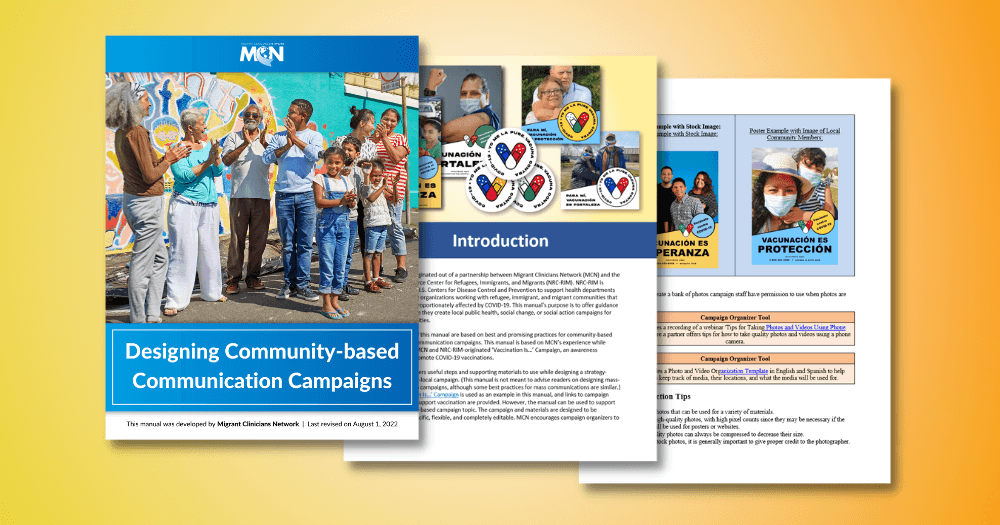
Across the US, rural, hard-to-reach agricultural worker communities have been severely impacted by the COVID-19 pandemic. Many of these communities differ from each other in important ways, from language, to culture, to age range, to access and integration with the larger community around them. Some agricultural worker communities are new immigrants; others have lived in the US for decades. Some are migrating with their families, and others are alone. Mass public health campaigns failed to successfully reach many of these communities which was one factor that increased COVID-related hardships. The pandemic exposed the critical need for hyper-local public health campaigns. “Hyper-local” is used to describe a small community that a campaign organizer wishes to reach that has a clearly defined geographic location and may also have its own distinct culture, norms, values, language, possibly language dialect, education level, and even employment type. Hyper-local communities are distinct from the target audiences of mass-communication campaigns, and even community-wide campaigns, because these campaigns often do not take into account the specific language, culture, environment, concerns, and misinformation that is circulating within these smaller communities. Campaigns that are designed for hyper-local communities can be more tailored, and therefore, connect better with target audiences.
The need for involvement of Community Health Workers, and other trusted health champions, and the knowledge and skills they bring, has been proven critical to successfully bring health messages to hard-to-reach communities. However, the task of feasibly implementing hyper-local campaigns can still be daunting, especially for health departments or health centers that are not already deeply connected with the local target audience, or for Community Health Workers who are new to the field.
Migrant Clinicians Network (MCN) is excited to offer a new resource, Designing Community-Based Communication Campaigns, a manual which offers detailed guidance to readers as they design public health, social change, or social action campaigns for hyper-local communities. The manual, which originated out of a partnership between MCN and the National Resource Center for Refugees, Immigrants, and Migrants (NRC-RIM), is based on best and promising practices for strategy-informed community-based public health campaigns. It also draws from MCN’s experience while executing the MCN- and NRC-RIM-originated ‘Vaccination Is...’ Campaign, an awareness campaign to promote COVID-19 vaccinations on the Eastern Shore of Virginia, Maryland, and Delaware, which sought to engage Spanish- and Haitian Creole-speaking vulnerable and primarily agricultural worker populations. The manual encourages the involvement of community members in the campaign-design process and offers useful steps to ensure campaign messages are relevant, and strategies meet the needs of the unique communities that organizers wish to reach. The manual also offers supporting materials from MCN’s free and fully customizable ‘Vaccination Is...’ campaign, which can be used for purposes beyond COVID-19.
The manual includes a wealth of information including:
- Community resource mapping
- Evaluating and selecting communication strategies and materials
- Photo and video consent and collection
- How to build and use a needs assessment
- Establishing campaign objectives and goals
- Choosing communication channels
- Building campaign tactics, strategy, and partnerships
- Campaign implementation strategies
- Evaluation, data collection, and reporting on the campaign
The new resource is a representation of MCN’s efforts to make health accessible to all and to enable health departments and community health centers to have an accessible resource to refer to during the seemingly complicated process of designing relevant hyper-local campaigns for communities that are often left out. The manual encourages campaign organizers to edit campaign strategies and materials to the specific needs of their own target communities. MCN hopes that the manual can help health advocates serving communities -- particularly those serving agricultural workers and other underserved and hard-to-reach communities -- to create successful and relevant campaigns. In addition to meaningfully impacting the health of our local communities, the effort hopes to expand health equity throughout the US and beyond by empowering health providers to craft and deliver relevant health messages to their communities.
MCN’s new manual, Designing Community-Based Communication Campaigns, is designed for both online-only use and for printing, with an extensive printable appendix of templates and resources, as well as embedded hyperlinks to online versions of the resources. It is now available at: https://www.migrantclinician.org/resource/designing-community-based-communication-campaigns-manual.html. A Spanish-language version of the manual will be available in the fall. Bilingual readers are encouraged to subscribe to our Spanish-language blog and e-newsletter to hear when new Spanish-language MCN resources and articles including the manual are released. Visit the Spanish-language blog here: https://www.migrantclinician.org/es/blog.
Read this article in the Summer 2022 issue of Streamline here!Sign up for our eNewsletter to receive bimonthly news from MCN, including announcements of the next Streamline. |